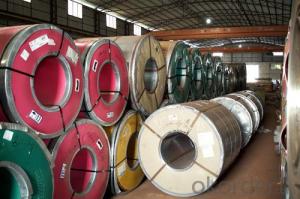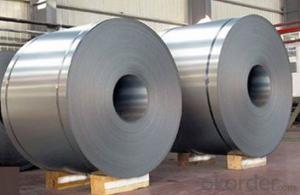Hot / Cold rolled Stainless Steel Coil
- Loading Port:
- Qingdao
- Payment Terms:
- TT OR LC
- Min Order Qty:
- -
- Supply Capability:
- 5000 m.t./month
OKorder Service Pledge
OKorder Financial Service
You Might Also Like
Hot / Cold Rolled Stainless Steel Coil
1. | Item | STAINLESS STEEL COIL | ||
2. | Standard | ASTM,AISI,GB,JIS,SUS,EN,DIN,etc. | ||
3. |
Material | 200 series | 300 series | 400 series |
201,202 | 300,301,304,304L,309S,310S,316Ti,316L, 317L,321,329,329LA,329LD | 409,410,430,430LX,600,601 | ||
4. |
Specification | Thickness | 0.1mm-200mm | |
Width | 1000mm-3000mm | |||
Length | 1m-12m | |||
5. | Surface | No.1,No.4,No.5,BA,2B,hair line,embossed,mirror finish,etc | ||
6. | Application | Stainless steel coils s are widely used in: 1:Chemical industry equipment,industrial tanks 2:Medical instruments,tableware,kitchen utensil,kitchen ware. 3:Architectural purpose,milk or food processing facilities. 4:Hospital equipment,interior exterior decoration for building 5:Architectural purposes,escalators,kitchen ware,vehicles. Or they can be made as your requirement. | ||
7. | Package | Standard export package. | ||
8. | Export to | Asia,Africa,Europe,Middle East,South and North America,Oceania,etc | ||
9. | Contact | please feel free to contact CNBM | ||
- Q:Can stainless steel strips be used for chemical reactors?
- Yes, stainless steel strips can be used for chemical reactors. Stainless steel is a popular choice for constructing chemical reactors due to its excellent corrosion resistance, high temperature resistance, and durability. It is capable of withstanding harsh chemical environments, making it suitable for a wide range of chemical reactions. Stainless steel strips provide a versatile and cost-effective option for constructing reactors, as they can be easily formed into desired shapes and sizes. Moreover, stainless steel is easy to clean and maintain, ensuring the integrity of the reactors and preventing contamination of the chemical processes.
- Q:Can stainless steel strips be used in the aerospace manufacturing industry?
- Yes, stainless steel strips can be used in the aerospace manufacturing industry. Stainless steel strips possess excellent strength, corrosion resistance, and high-temperature resistance properties, making them suitable for various aerospace applications such as aircraft frames, structural components, engine parts, and fasteners.
- Q:Can stainless steel strips be used in the production of medical instruments for sterilization?
- Indeed, the utilization of stainless steel strips is possible for the manufacturing of medical instruments intended for sterilization purposes. The widespread preference for stainless steel as a material for medical instruments is attributable to its remarkable resistance to corrosion, robustness, and enduring nature. Moreover, stainless steel exhibits exceptional resistance towards heat, enabling it to endure the elevated temperatures necessary for sterilization techniques such as autoclaving. Additionally, stainless steel possesses non-reactive qualities and does not release any harmful substances, thus ensuring its safety for employment in medical applications. Consequently, stainless steel strips prove to be a suitable material for the production of medical instruments necessitating sterilization.
- Q:What is the tensile strength after annealing of stainless steel strips?
- The tensile strength of stainless steel strips increases after annealing.
- Q:What are the recommended machining techniques for 111 stainless steel strips?
- When it comes to machining 111 stainless steel strips, there are several recommended techniques that can ensure optimal results. 1. Cutting: For cutting stainless steel strips, it is advisable to use a high-speed steel (HSS) saw blade or a carbide-tipped saw blade. These blades are known for their hardness and durability, allowing for efficient and precise cuts. Additionally, using a lubricant during the cutting process can help reduce friction and heat buildup. 2. Drilling: When drilling holes in stainless steel strips, it is recommended to use a cobalt or carbide drill bit. These materials can withstand the high hardness of stainless steel and maintain their sharpness for longer periods. It is also important to use a cutting lubricant to prevent overheating and extend the life of the drill bit. 3. Grinding: Grinding stainless steel strips can be achieved using a variety of abrasive wheels, such as aluminum oxide or ceramic. These wheels are designed to handle the hardness of stainless steel and provide a smooth and consistent finish. It is essential to use a coolant during grinding to prevent overheating and maintain the integrity of the strip's surface. 4. Bending: When bending stainless steel strips, it is crucial to use proper tooling to avoid deformation or cracking. Using a press brake or a roller with rounded edges can help achieve precise and uniform bends without causing damage to the strip. Additionally, annealing the strip before bending can make it more pliable and reduce the risk of cracking. 5. Welding: Stainless steel strips can be welded using various techniques, such as TIG (Tungsten Inert Gas) or MIG (Metal Inert Gas) welding. It is important to use a filler material compatible with the specific grade of stainless steel being used. Preheating the strip before welding can help reduce distortion and improve the quality of the weld. Overall, it is crucial to select the appropriate tools and techniques for machining stainless steel strips to ensure the best results. It is also recommended to consult the manufacturer's guidelines or seek the advice of a professional machinist for specific recommendations tailored to the particular grade of stainless steel being processed.
- Q:Are stainless steel strips available in different widths?
- Yes, stainless steel strips are available in different widths.
- Q:How do stainless steel strips perform in cryogenic environments?
- Stainless steel strips perform well in cryogenic environments as they exhibit excellent resistance to low temperatures, maintaining their strength, toughness, and corrosion resistance.
- Q:Are 111 stainless steel strips suitable for cryogenic storage tanks?
- 111 stainless steel strips are indeed suitable for cryogenic storage tanks. This particular type of stainless steel, known as 111, possesses desirable qualities such as excellent corrosion resistance, high strength, and good toughness. These attributes make it an ideal option for cryogenic applications, as it can endure extremely low temperatures without becoming brittle or losing its mechanical properties. Moreover, 111 stainless steel is known for its weldability and formability, which simplifies the fabrication process required to shape it for cryogenic storage tanks. Ultimately, the utilization of 111 stainless steel strips guarantees the safety and efficiency of cryogenic liquid or gas storage, as they are a dependable and long-lasting material choice.
- Q:Can stainless steel strips be electroplated?
- Yes, stainless steel strips can be electroplated. Electroplating is a process in which a thin layer of metal is deposited on the surface of an object using an electric current. While stainless steel is already corrosion-resistant, electroplating can enhance its appearance, provide additional protection against wear and tear, and improve its conductivity. The process involves immersing the stainless steel strip in a bath containing a solution of metal ions and applying an electric current, causing the metal ions to be attracted and deposited onto the surface of the strip. This can be done with various metals, such as gold, silver, nickel, or chromium, to achieve different aesthetic or functional properties.
- Q:What is the corrosion resistance of stainless steel strips in saltwater?
- In saltwater environments, stainless steel strips exhibit exceptional resistance against corrosion. The presence of a substantial amount of chromium in stainless steel results in the formation of a protective layer of chromium oxide on the surface. This layer acts as a barricade against corrosion and prevents any chemical reaction between the metal and saltwater. Consequently, stainless steel strips possess remarkable resistance to rust and corrosion caused by exposure to saltwater. Moreover, stainless steel is highly resistant to pitting corrosion, a prevalent form of corrosion in saltwater environments. Hence, stainless steel strips find extensive application in marine sectors, such as shipbuilding and offshore structures, where they encounter saltwater conditions.
1. Manufacturer Overview |
|
|---|---|
| Location | |
| Year Established | |
| Annual Output Value | |
| Main Markets | |
| Company Certifications | |
2. Manufacturer Certificates |
|
|---|---|
| a) Certification Name | |
| Range | |
| Reference | |
| Validity Period | |
3. Manufacturer Capability |
|
|---|---|
| a)Trade Capacity | |
| Nearest Port | |
| Export Percentage | |
| No.of Employees in Trade Department | |
| Language Spoken: | |
| b)Factory Information | |
| Factory Size: | |
| No. of Production Lines | |
| Contract Manufacturing | |
| Product Price Range | |
Send your message to us
Hot / Cold rolled Stainless Steel Coil
- Loading Port:
- Qingdao
- Payment Terms:
- TT OR LC
- Min Order Qty:
- -
- Supply Capability:
- 5000 m.t./month
OKorder Service Pledge
OKorder Financial Service
Similar products
New products
Hot products
Hot Searches
Related keywords

































